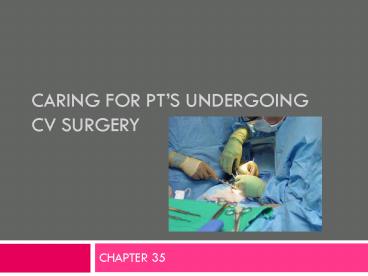CARING FOR PTS UNDERGOING CV SURGERY - PowerPoint PPT Presentation
1 / 15
Title:
CARING FOR PTS UNDERGOING CV SURGERY
Description:
Before the 1950s, few attempts at cardiac surgery were made. ... atherosclerotic plaques from the carotid, femoral, or popliteal arteries. ( fig. 35-10 pg. ... – PowerPoint PPT presentation
Number of Views:133
Avg rating:3.0/5.0
Title: CARING FOR PTS UNDERGOING CV SURGERY
1
CARING FOR PTS UNDERGOING CV SURGERY
- CHAPTER 35
2
OVERVIEW
- Before the 1950s, few attempts at cardiac surgery
were made. - Initially, hypothermia and crude mechanisms for
oxygenating blood outside the body were used. - In the 1960s, the technique for mechanically
circulating and oxygenating blood outside the
body, called extracorporeal circulation or
cardiopulmonary bypass (Fig. 35-1) pg. 531
3
OVERVIEW
- Removing blood from the venae cavae, circulating
it through an oxygenator, and returning it to the
aorta or femoral artery provides a nearly
bloodless area while the beating heart is
stopped.
4
Cardiac Surgical Procedures
- Cardiac surgery is used to correct and treat
various cardiac disorders. - It is done to revascularize the myocardium,
repair or replace cardiac valves, repair
ventricular aneurysm, remove heart tumors, manage
heart trauma, and replace the heart with one from
a human donor.
5
MYOCARDIAL REVASCULARIZATION
- Myocardial revascularization refers to surgical
techniques that improve the delivery of
oxygenated blood to the myocardium for clients
who have CAD. - It is accomplished by performing one or more
coronary artery bypass grafts. - CABG improves myocardial oxygenation by bypassing
or detouring around the occluded portion of one
or more coronary arteries with a relocated blood
vessel.
6
MYOCARDIAL REVASCULARIZATION
- The saphenous vein in the leg is the vessel most
often used for grafting. - It is harvested by making a long incision on the
medial aspect of the leg or by removing the vein
endoscopically through one to three small (1
inch) leg incisions. (fig. 35-2).
7
MYOCARDIAL REVASCULARIZATION
- CABG is reserved for client with CAD who are not
candidates for less invasive procedures like
PTCA.
8
MYOCARDIAL REVASCULARIZATION
- CABG performed when
- (1) the client has multiple coronary artery
occlusions - (2) the atheromas are calcified and
noncompressible - (3) the anatomic location of the occlusion(s)
interferes with the safe insertion of a coronary
artery catheter.
9
Vascular Grafts pg. 536
- Vascular Grafts Just as grafts are used to
bypass a disease section of a coronary blood
vessel, vascular grafts are used to bypass or
replace diseased sections of major systemic blood
vessels such as the aorta or femoral arteries. - The replacement graft may be made of synthetic
fiber, such as Dacron or Teflon, or may be human
tissue harvested from cadavers.
10
Embolectomy Thrombectomy
- Embolectomy Thrombectomy when thrombi or
emboli occlude a major vessel, a thrombectomy
(removal of a thrombus) or embolectomy (removal
of an embolus) is performed. - The vessel is opened about the clot, the clot is
removed, and the vessel is sutured closed. - May be emergent surgery because complete
occlusion results in loss of blood supply to an
area.
11
ENDARTERECTOMY
- Endarterectomy is the resection and removal of
the lining of an artery. - This type of surgery is performed to remove
obstructive atherosclerotic plaques from the
carotid, femoral, or popliteal arteries. (fig.
35-10 pg. 537)
12
NURSING PROCESS
- ASSESSMENT
- Obtains medical and surgical hx.
- Performs physical exam
- Determines drug allergies
- Weigh the client
- Records V/S and measures I O
- Prepares for extensive diagnostic testing
13
NURSING PROCESS
- After surgery
- Palpate the peripheral pulses or uses a doppler
ultrasound device if the pulses are not palpable. - Check for inadequate tissue perfusion, such as a
weak or absent pulse, cold or cyanotic extremity,
or skin mottling. - Asses BP and pulse rate in both arms after
thoracic surgery. - Inspect IV sites and infusions
14
NURSING PROCESS
- Hourly IO
- Neurologic assessment every 30 minutes (LOC,
pupils, movement in both arms and legs, verbal
response, and status or orientation)
15
Care Plan
- Go over the care plan on pg. 538 540.
- Client and family teaching 35-1 pg 541.
- Nutritional, pharmacologic and gerontologic
considerations.































